La Madeleine and Mysticism
Many people are attracted by the hidden history of human civilization and the secrets of nature. We wonder where and how we can find the truth. The search for the truth is an inbuilt quality of the human being, which will eventually lead him or her towards soul growth.
History has been divided into two lines:
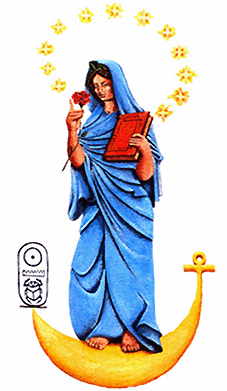 We prepare ourselves by studying symbolism. Symbolism will give us a key towards the understanding of many secret signs and symbols used by initiates of several ancient orders and we find those symbols in many paintings, statues, carvings, cathedrals (especially the Gothic ones), coats of arms, etc. Let us look at the painting on the right. This is not Mother Mary. This is Mary Magdalene, Mariamne Migdal Eder, Watcher of the Tower (holistic astrologer) and the presumed companion and beloved disciple of Jesus in the 1st Century AD. She holds a closed book, which betrays that the history around her is not easy to discover. In her right hand she carries the mystical red rose, which refers to soul growth and the Great Work. Also, her index finger is pointing upwards. This is the so called 'John Gesture'. It refers to John the Baptist, Abba Yehohanan, who plays an important but forgotten role in history as Prince and King of Israel. Her hair is made up in the Egyptian style and the crescent moon she stands on is flanked by an Ankh and the seal of Amenhotep III, the founder of the Rosicrucians and father of Akhenaten. So, what does Mary Magdalene have in common with Egypt? Why is her skin colour dark and why is she standing on the crescent moon? Why does she have 12 stars around her head? Some of you will recognise symbols of the ancient Mother Goddess, who has had many names in the past. And here, with Mother Earth, everything begins.
We prepare ourselves by studying symbolism. Symbolism will give us a key towards the understanding of many secret signs and symbols used by initiates of several ancient orders and we find those symbols in many paintings, statues, carvings, cathedrals (especially the Gothic ones), coats of arms, etc. Let us look at the painting on the right. This is not Mother Mary. This is Mary Magdalene, Mariamne Migdal Eder, Watcher of the Tower (holistic astrologer) and the presumed companion and beloved disciple of Jesus in the 1st Century AD. She holds a closed book, which betrays that the history around her is not easy to discover. In her right hand she carries the mystical red rose, which refers to soul growth and the Great Work. Also, her index finger is pointing upwards. This is the so called 'John Gesture'. It refers to John the Baptist, Abba Yehohanan, who plays an important but forgotten role in history as Prince and King of Israel. Her hair is made up in the Egyptian style and the crescent moon she stands on is flanked by an Ankh and the seal of Amenhotep III, the founder of the Rosicrucians and father of Akhenaten. So, what does Mary Magdalene have in common with Egypt? Why is her skin colour dark and why is she standing on the crescent moon? Why does she have 12 stars around her head? Some of you will recognise symbols of the ancient Mother Goddess, who has had many names in the past. And here, with Mother Earth, everything begins.
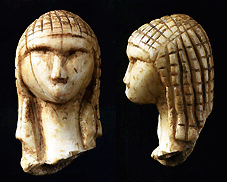 There are rumours that we haven't exactly found out everything about the history of our civilization. In fact, we know not even 1% of our history. Many traces of our past have been destroyed by disasters of nature and although orthodox historians and archaeologists refuse to believe that mankind is older than we may think, others are bringing in proof after proof that there was a civilization older than Jericho, older than Genesis. Maybe there was no Genesis. Maybe Genesis is just a symbolic story and we must look for the truth elsewhere. I'm sure that soon, books will be published with solid proof of the worlds of Atlantis and Lemuria. Traces of civilizations have been found which are many millennia older than our history books suggest and this shouldn't be a surprise. If the earth is billions of years old and the first upright humans walked on the earth at least 5 million years ago and were soon able to make a fire, then I am sure there have been at least several high civilizations that have been destroyed in some kind of natural catastrophe.
There are rumours that we haven't exactly found out everything about the history of our civilization. In fact, we know not even 1% of our history. Many traces of our past have been destroyed by disasters of nature and although orthodox historians and archaeologists refuse to believe that mankind is older than we may think, others are bringing in proof after proof that there was a civilization older than Jericho, older than Genesis. Maybe there was no Genesis. Maybe Genesis is just a symbolic story and we must look for the truth elsewhere. I'm sure that soon, books will be published with solid proof of the worlds of Atlantis and Lemuria. Traces of civilizations have been found which are many millennia older than our history books suggest and this shouldn't be a surprise. If the earth is billions of years old and the first upright humans walked on the earth at least 5 million years ago and were soon able to make a fire, then I am sure there have been at least several high civilizations that have been destroyed in some kind of natural catastrophe.
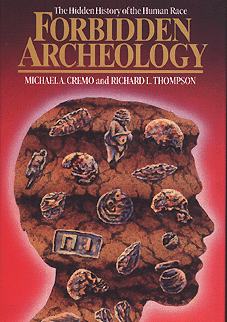 The ancient people may have used a different science than we use today. Their science may be worth studying, so we can use it ourselves today. For example: The knowledge of medicine (herbs, flowers, plants, stones, energies, etc.), the power of the mind, the use of the earth's treasures e.g. crystals and stones, the science of vibration & sound, the knowledge of the soul, of nature, of the stars, of the future... That is why we need to get rid of our blinkers, think out of the box and learn from our ancestors, learn their science and see if it can aid ours. Why are there so many people against exploring the true origins of civilization? In the last 2000 years, powerful world ruling groups have carefully hidden many truths. To dominate the world, rulers need to keep the people stupid. Many people were forced to follow one specifically organized faith, so they could be controlled. All 'freethinkers' were killed, many times through the 'purge' of fire. The ancient knowledge - which was still present in the 1st century - would be carefully rooted out within the next 1500 years, but it didn't fall into oblivion. Ancient orders kept the knowledge safe and alive and passed it on orally, so not all was lost and sometimes we even discover hidden knowledge in symbolism, folktales, fairy tales, myths and legends, but also in cultures such as the Celts, who had taken over many things from e.g. the Egyptians. Think of the obelisks (Karnak Egypt, Carnac France), the enhancement of vibration (dolmens - temples/pyramids), their cult of the Mother Goddess and traces of Egyptian art in their artefacts (e.g. Gullgubbene, Scandinavia). So for those who seek the truth: The hidden history and hidden knowledge of the ancients is still among us, everywhere.
The ancient people may have used a different science than we use today. Their science may be worth studying, so we can use it ourselves today. For example: The knowledge of medicine (herbs, flowers, plants, stones, energies, etc.), the power of the mind, the use of the earth's treasures e.g. crystals and stones, the science of vibration & sound, the knowledge of the soul, of nature, of the stars, of the future... That is why we need to get rid of our blinkers, think out of the box and learn from our ancestors, learn their science and see if it can aid ours. Why are there so many people against exploring the true origins of civilization? In the last 2000 years, powerful world ruling groups have carefully hidden many truths. To dominate the world, rulers need to keep the people stupid. Many people were forced to follow one specifically organized faith, so they could be controlled. All 'freethinkers' were killed, many times through the 'purge' of fire. The ancient knowledge - which was still present in the 1st century - would be carefully rooted out within the next 1500 years, but it didn't fall into oblivion. Ancient orders kept the knowledge safe and alive and passed it on orally, so not all was lost and sometimes we even discover hidden knowledge in symbolism, folktales, fairy tales, myths and legends, but also in cultures such as the Celts, who had taken over many things from e.g. the Egyptians. Think of the obelisks (Karnak Egypt, Carnac France), the enhancement of vibration (dolmens - temples/pyramids), their cult of the Mother Goddess and traces of Egyptian art in their artefacts (e.g. Gullgubbene, Scandinavia). So for those who seek the truth: The hidden history and hidden knowledge of the ancients is still among us, everywhere.
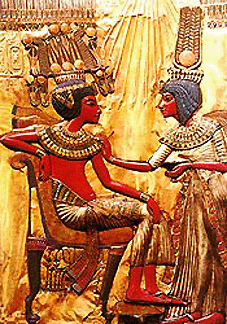 Egypt
Egypt
Everyone knows that Egypt has a mystical culture dating back to pre-history. Their origin is still a mystery, their culture based on an older civilization and their great wisdom and power lives on in ancient orders such as the Rosicrucians. Powerful gods and goddesses ruled the world of the ancient Egyptians. In the west was the land of Sah and Ra; the underworld of Osiris and the tomb of the sun god Ra. The star systems in the heavens were copied onto the earth to make a symbolic gateway to their realms. Osiris and Isis, brother and sister as well as husband and wife, ruled the land and the afterlife, took care of the fertility of the earth so that the earth would produce food and drink, the body and blood of the mother goddess, for it is mother earth that we eat and drink. Isis gave birth to Horus and paved the road for future Christianity. Isis was the mother goddess, beloved by all. Around 1350 BC, around the time of Akhenaten in Egypt, there was a growing domination of the one and only god - who was both male and female - and it was in those days that Moses and Aaron took many things from the Egyptians, built the Ark of the Covenant and waited in the Sinai desert until the aftermath of the Santorini volcano eruption had died out and their goal, the 'promised land', would be habitable again. They had taken many things from the Egyptians. Perhaps also the god Thoth's laws and knowledge which was kept in a secret chamber to which a high priest only had access. Aaron was the High Priest of On (Heliopolis) before the Exodus. However, at a certain point in time, the mother goddess was no longer acknowledged as God's bride.
The children of Israel rebuilt the country and five centuries went by until the reign of David and Salomon. The Ark of the Covenant, which had been built just like all the other Egyptian mobile shrines that carried gods and goddesses, was about to be placed in a new temple in a new capital. Perhaps the knowledge of natural science; the wisdom of the ancients; the wisdom of Thoth, the Egyptian God of e.g. law and medicine, was kept inside the Ark. Since the days of Moses to the 1st century of our era (a period of 1350 years), the Jewish religion evolved and many separate cults, sects and orders were formed. The Mother Goddess became much less important, pushed aside by a lonely but dominant male deity and although Christianity tried to fill her empty throne by placing on it Jesus' Mother Mary, her origin practically disappeared.
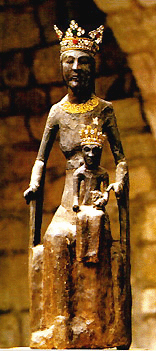 It is said that Mary Magdalene, a feminist, tried to give new life to the cult of the Mother Goddess or Black Madonna/Black Isis cult in France, where she may have spent the rest of her life. It is still not proven that she went there at all, but in folklore, in symbolism and in hidden books, many traces point very clearly in this direction. She most probably promoted the Black Madonna cult - the cult of Mother Earth - and at that time she was seen as the reincarnation of the goddess Isis or Artemis. Many churches dedicated to La Madeleine or Mary here in France are built on top of ancient Celtic sites with a sacred water source. The source is a very powerful symbol of the Mother Goddess.
It is said that Mary Magdalene, a feminist, tried to give new life to the cult of the Mother Goddess or Black Madonna/Black Isis cult in France, where she may have spent the rest of her life. It is still not proven that she went there at all, but in folklore, in symbolism and in hidden books, many traces point very clearly in this direction. She most probably promoted the Black Madonna cult - the cult of Mother Earth - and at that time she was seen as the reincarnation of the goddess Isis or Artemis. Many churches dedicated to La Madeleine or Mary here in France are built on top of ancient Celtic sites with a sacred water source. The source is a very powerful symbol of the Mother Goddess.
It isn't surprising that Mother Mary, the 'Notre Dame' and 'La Madeleine' easily get mixed up. Both are often pictured with a blue robe, with stars around their heads, usually standing on a crescent moon or carrying a child. Although this refers to Mother Goddess symbolism, in history it is very likely that both women had children. According to Barbara Thiering, Maria Magdalene had 3 children with Jesus: Jesus Justus who followed Jesus' footsteps, Tamar who is said to have married Paul and a youngest son, thought to be John, who wrote the Book of Revelation in cryptic code containing many hidden messages. Especially the youngest child, who she had allegedly taken to France and with whom she may have been portrayed many times in history, could be confused with Jesus resting in Mother Mary's arms, but it doesn't matter who is who; it matters that they both represent God's lost bride; the Mother Goddess, the forgotten divine feminine that was once inseparable from Osiris, the divine masculine.
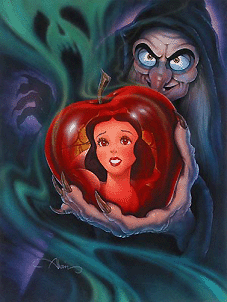 This is interesting, because it is exactly this that we find in many a fairy tale. The prince in search of his princess, or the other way around. The princess fleeing for her life while chased by a wicked witch like in Snow White, or kept in a lonely tower away from men, like in Rapunzel. There may be a hidden symbolic connection between the name Septimania (an ancient Jewish Princedom in southern France) and the Seven Dwarfs from Snow White. Septimania was a place of refuge for Jewish refugees who had fled from Israel in the 1st century to escape the harsh Roman supression, so it may well have been a place of refuge for Mary Magdalene and many of her family and friends. Though the seven dwarfs protected Snow White, she was hunted down by the wicked queen. It's as if the fairy tale is a parable: the Magdalene's evolved cult was almost wiped out during the crusade against the Cathars in the 13th and 14th century and Snow White, well, she ate the poisoned apple, didn't she?
This is interesting, because it is exactly this that we find in many a fairy tale. The prince in search of his princess, or the other way around. The princess fleeing for her life while chased by a wicked witch like in Snow White, or kept in a lonely tower away from men, like in Rapunzel. There may be a hidden symbolic connection between the name Septimania (an ancient Jewish Princedom in southern France) and the Seven Dwarfs from Snow White. Septimania was a place of refuge for Jewish refugees who had fled from Israel in the 1st century to escape the harsh Roman supression, so it may well have been a place of refuge for Mary Magdalene and many of her family and friends. Though the seven dwarfs protected Snow White, she was hunted down by the wicked queen. It's as if the fairy tale is a parable: the Magdalene's evolved cult was almost wiped out during the crusade against the Cathars in the 13th and 14th century and Snow White, well, she ate the poisoned apple, didn't she?
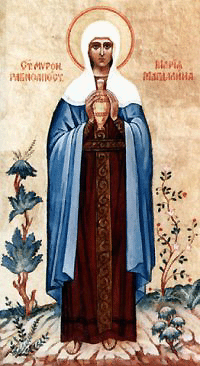 Grail and The Female Principle
Grail and The Female Principle
Occitania is an area where history has had full reign. The Celts and pre-celtic peoples worshipped the Mother Goddess. Their holy sites were holy water sources, caves, mountains and tellurian power lines on which they would place their dolmens and menhirs. The first connection we see is the cult of the bear, which is still celebrated in the mysterious Pyrenees. The bear was the incarnation of Odin in the northern Celtic world, while in the orient it was the companion of Artemis. We have the Great Bear (Ursus Major) and the Little Bear (Ursus Minor) in the stars and the bear was also a symbol of the moon and of resurrection. 'Arth Ur' means 'The Bear' and was the title of the leader of a tribe. Of course we think of another myth when we see the name Arthur. Also the name Arcas means 'bear' and there is a small village in the Corbières region of France called Arques (Arcas in Occitan).
 Around the 7th century BCE, the Mediterranean coast of Occitania was colonised by the Phoenicians and later by the Greeks and Romans. With them, they brought their cultures. There were also flourishing Jewish and Essene communities in this region and these people are considered to have been the ones who had brought viniculture to France, just a little while before the Romans arrived. The vine is a very powerful symbol in the Grail legends. Jesus was sometimes symbolised as a vine, as well as his 'forbidden' bloodline. Of course, Arthur and the Grail legends are connected and from the grail we once again arrive at Mary Magdalene and the alabaster jar. In it she kept the Nardus oil with which she anointed Jesus to become the Messiah, which means 'the anointed one'. However, we must consider that the presence of the jar could also simply refer to the Mother Goddess, since other Goddesses of Fertility in the Orient (for example Kuan Yin) are also depicted with a jar. The jar stands for the body, its contents for the soul.
Around the 7th century BCE, the Mediterranean coast of Occitania was colonised by the Phoenicians and later by the Greeks and Romans. With them, they brought their cultures. There were also flourishing Jewish and Essene communities in this region and these people are considered to have been the ones who had brought viniculture to France, just a little while before the Romans arrived. The vine is a very powerful symbol in the Grail legends. Jesus was sometimes symbolised as a vine, as well as his 'forbidden' bloodline. Of course, Arthur and the Grail legends are connected and from the grail we once again arrive at Mary Magdalene and the alabaster jar. In it she kept the Nardus oil with which she anointed Jesus to become the Messiah, which means 'the anointed one'. However, we must consider that the presence of the jar could also simply refer to the Mother Goddess, since other Goddesses of Fertility in the Orient (for example Kuan Yin) are also depicted with a jar. The jar stands for the body, its contents for the soul.
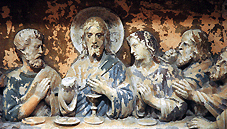 Where there is smoke there is fire and we are beginning to understand that Mary Magdalene may have been Jesus' wife, especially because a Rabbi could only be called a Rabbi when he was married, preferably with children. On the right we see a relief from the church of Saint Volusien in Foix, depicting the Last Supper. It is clear that the person sitting at Jesus' left hand side is a woman, Mary Magdalene (with special thanks to author Bram Moerland for the photo). If there is any doubt whether the person next to Jesus on Da Vinci's Last Supper is a woman or not, this Last Supper reveals it clearly. Sitting next to the Master confirms her position. If they were indeed married, there may have been children and there is no reason why there would be no bloodline from them.
Where there is smoke there is fire and we are beginning to understand that Mary Magdalene may have been Jesus' wife, especially because a Rabbi could only be called a Rabbi when he was married, preferably with children. On the right we see a relief from the church of Saint Volusien in Foix, depicting the Last Supper. It is clear that the person sitting at Jesus' left hand side is a woman, Mary Magdalene (with special thanks to author Bram Moerland for the photo). If there is any doubt whether the person next to Jesus on Da Vinci's Last Supper is a woman or not, this Last Supper reveals it clearly. Sitting next to the Master confirms her position. If they were indeed married, there may have been children and there is no reason why there would be no bloodline from them.
Jesus was a great Avatar; a Master and a healer; a holy man, who has said and done many good things. However, his ancestors are a mystery to us. In contrary to what people think, Jesus was no orthodox Jew but an Essene. Orthodox Jews called the Essenes 'Nazareni', which means 'heretics'. When we believe that Jesus had a physical body, nature demands him to have had a father as well as a mother. So, who was his earthly father? There are many theories about this. However, one possibility may have been overlooked. Perhaps High Priest/Zadok Priest Zachariah, the last male heir of the Hasmonean Royal House, is the real father of Jesus. Mary - daughter of Ann and Joachim who were from an important noble lineage - could have been chosen to give birth to Zachariah son, because his childless wife Elisabeth had become too old to get pregnant. The story could have been something like this: After impregnating Mary, it came out that Elisabeth was a few months pregnant after all and both women would give birth to sons. First, John (the Baptist), quickly followed by Jesus. This theory would explain much, as it would make John the king of Israel before Jesus. After John's death, Jesus would follow him up and become the anointed king of Israel and Judea, as well as Zadok priest, but the Romans refused to recognise him and seeing him as a threat to the Roman Empire, they had him crucified. They even mocked him by putting up a sign above his head, saying: 'Iesu Nazareni Rex Iudorum'. Jesus the heretic, king of the Jews.
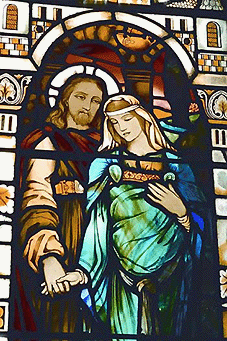 People have gone to great lengths to find out what his family tree really looks like and somehow they end up in the middle of several ruling classes in a turbulent medieval Europe. Think of Charlemagne, the house of Champagne and the first 9 (or 11?) knights of the Knights Templar, who just wanted to invade Jerusalem to retrieve a few what they considered family possessions and then leave. Many traces lead toward the Templar knights when we research the above. Noble families such as the Medici and many others in Europe intermarried because of this bloodline and thinking about this vine-bloodline, the term 'blue blood' may well have originated from this idea. When talking about important bloodlines for a personal research project, then it is interesting to dive into the origins of the Irish Tuatha de Danaan, the Celts, the 10 lost tribes of Israel, the Zadok Priesthood, the Tribe of Dan, the Royal Scyths (Isaac?), the origins of the Goths and Merovingians, the Saint Clair family, the Scottish Stewart family and the Habsburgs. One of the most probable heirs of the Grail bloodline could even be Karl von Habsburg. Whether this Grail bloodline has anything to do with Jesus or King David cannot be proven 100%, as historical records have been conveniently altered to fit the picture in many cases, but it is well possible that the Habsburg lineage is the oldest royal bloodline in the world. Now, their priorities are humanitarian and social work and of course, chivalry. Not for their glory, but for the glory of God.
People have gone to great lengths to find out what his family tree really looks like and somehow they end up in the middle of several ruling classes in a turbulent medieval Europe. Think of Charlemagne, the house of Champagne and the first 9 (or 11?) knights of the Knights Templar, who just wanted to invade Jerusalem to retrieve a few what they considered family possessions and then leave. Many traces lead toward the Templar knights when we research the above. Noble families such as the Medici and many others in Europe intermarried because of this bloodline and thinking about this vine-bloodline, the term 'blue blood' may well have originated from this idea. When talking about important bloodlines for a personal research project, then it is interesting to dive into the origins of the Irish Tuatha de Danaan, the Celts, the 10 lost tribes of Israel, the Zadok Priesthood, the Tribe of Dan, the Royal Scyths (Isaac?), the origins of the Goths and Merovingians, the Saint Clair family, the Scottish Stewart family and the Habsburgs. One of the most probable heirs of the Grail bloodline could even be Karl von Habsburg. Whether this Grail bloodline has anything to do with Jesus or King David cannot be proven 100%, as historical records have been conveniently altered to fit the picture in many cases, but it is well possible that the Habsburg lineage is the oldest royal bloodline in the world. Now, their priorities are humanitarian and social work and of course, chivalry. Not for their glory, but for the glory of God.
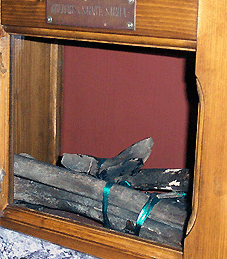 The Grail legends
The Grail legends
According to Barbara Thiering, an authority on the Dead Sea Scrolls, Mary Magdalene was born in 3 AD, married Jesus and was banished by the Jews to an Essene colony in southern France around 44 CE. She wasn't alone; others also travelled to French shores. According to the legends, also Lazarus, Sidonius, Myriam Jacobe, Myriam Salome and Myriam Martha had come over. One story tells us how 2 of the Mary's (Mary Jacobe and Mary Salome) landed in the Provence just north of the Herault, near what is now called Stes Maries de la Mer in the Camarque. It was a local gypsy girl called Sarah, however, who became the patron saint of all the Gypsies. According to the gypsy legend of the Camarque, Sarah had rescued a ship in need who had come from Egypt by fetching help from a nearby fishing village. Still each year during the gypsy festival, this event is celebrated. The statue of sainte Sarah (and thus: not a black Madonna) is being carried through the streets of the village and taken into the sea to welcome the saints. There is no mention of Mary Magdalene in the gypsy legend. The Magdalen had probably come ashore somewhere else. Sarah's relics are still kept in the church. It is said that one of the Mary's had brought an object with which they could see the future. Sarah supposedly 'stole from the sun' by means of a stone. The gypsy with the crystal ball comes to mind, but also the Biblical Urim and Thummim divination stones, which once belonged to Zadok priest Aaron, brother of Moses. Perhaps these stones have been passed down in the Zadok priest's family bloodline?
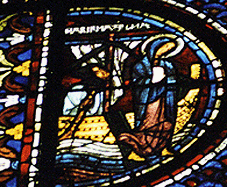 According to a legend, Mary Magdalene brought the Grail to France. We see here on the left how she arrived in France on a detail from a window in Chartres Cathedral. The Grail is, according to many, the cup Jesus drank from during his last meal. The cup that caught his blood after he had been pierced in his side by the Roman soldier Longinus during the crucifixion. This reminds me of an old ritual called the Hieros Gamos ritual. In the days of old, a small bowl was used to collect sacrificial blood. This blood would ensure the fertility of the earth for next year's crop (fertility cult). Of course Jesus' blood was also sacrificial and his sacrifice would ensure the fertility of the earth, or, in the case of the Christian dogma, the salvation of mankind. So, if Jesus' cup had indeed been brought to Europe - either by Joseph of Arimathea (Glastonbury) or Maria Magdalene (France) - then it may even exist as a material object and this reminds me of the famous cup of Melchizedek, who also did the bread and wine ritual thousands of years BCE. Since this ritual must have been done by many people throughout the centuries and if the cup should still exist, then it must have been made of unbreakable material.
According to a legend, Mary Magdalene brought the Grail to France. We see here on the left how she arrived in France on a detail from a window in Chartres Cathedral. The Grail is, according to many, the cup Jesus drank from during his last meal. The cup that caught his blood after he had been pierced in his side by the Roman soldier Longinus during the crucifixion. This reminds me of an old ritual called the Hieros Gamos ritual. In the days of old, a small bowl was used to collect sacrificial blood. This blood would ensure the fertility of the earth for next year's crop (fertility cult). Of course Jesus' blood was also sacrificial and his sacrifice would ensure the fertility of the earth, or, in the case of the Christian dogma, the salvation of mankind. So, if Jesus' cup had indeed been brought to Europe - either by Joseph of Arimathea (Glastonbury) or Maria Magdalene (France) - then it may even exist as a material object and this reminds me of the famous cup of Melchizedek, who also did the bread and wine ritual thousands of years BCE. Since this ritual must have been done by many people throughout the centuries and if the cup should still exist, then it must have been made of unbreakable material.
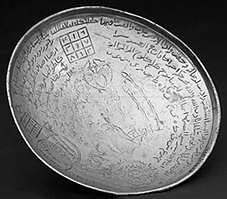 So what about the Goral, a Hebrew word for 'Divination', referring to a (usually silver or golden) bowl - that often contained inscriptions and a magical square - and was used for divination. It was also used as a medicine cup, so the bearer could drink from it when ill. The drinker would then be healed from disease or poisoning, or simply remain healthy. Genesis 44 starts with Joseph who has his men hide his special cup in the luggage of one his brothers and it is referred to as the special cup that Joseph drank from and which he used for divination. This is of interest, because the word 'Goral' may have been the root of the word 'Grail'.
So what about the Goral, a Hebrew word for 'Divination', referring to a (usually silver or golden) bowl - that often contained inscriptions and a magical square - and was used for divination. It was also used as a medicine cup, so the bearer could drink from it when ill. The drinker would then be healed from disease or poisoning, or simply remain healthy. Genesis 44 starts with Joseph who has his men hide his special cup in the luggage of one his brothers and it is referred to as the special cup that Joseph drank from and which he used for divination. This is of interest, because the word 'Goral' may have been the root of the word 'Grail'.
Of course there is a spiritual side to the material cup. Its spiritual symbolism. The search for a higher level of being; soul growth; the search for your inner wisdom and, of course, knowledge of the Hermetica to understand the big why and how and the concept of God and here we arrive exactly on the spot. It all seems to deal with the keeping and protecting of ancient, forbidden knowledge. Graham Hancock, together with Robert Bauval an authority on lost civilizations, has a strong feeling that the Grail and the Ark of the Covenant are - in a deeper symbolism - one and the same. In reality they may have existed as solid objects and are still very much sought after, but its symbolic value is far more important to us. What good is a beautiful book cover when you can't read the book? So in medieval times, when books as well as people were mercilessly burned when they did not follow the Roman Catholic power cult, it is no wonder that secret orders were working underground to protect all this knowledge, to keep it from oblivion.
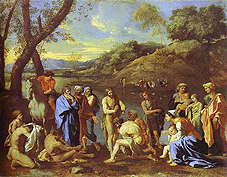 The great Brotherhoods
The great Brotherhoods
True initiates of the ancient orders were able to recognise the hidden messages in paintings and statues and other symbols. For outsiders, the question remains: what does it all mean? Here, Poussin - one of the initiates - has painted John the Baptist, the heir of Aaron, keeper of the Ark and immediately we spot the X in the trees. The X may refer to several things. St. Andrew is the patron saint of Scotland, so could it be referring to Scotland? Or does it refer to the Essene greeting, crossed arms with the right hand on the heart, a blink towards the knowledge of the Great White Brotherhood? Could it be the combination of the male symbol (^) and the female symbol (v)? Keep an eye out for the X in all paintings, images and statues as it may refer to a connection which is completely surprising. Or perhaps not...
However, there is one thing we may not overlook and that is the Female Principle, the Mother Goddess, Isis under her veil and the mysterious La Madeleine with her Mysticism. Mary Magdalene, as a feminist, was not very popular among the male disciples, for women in the orient - especially at that time - weren't considered equal. Jesus, however, was very fond of her and according to the Bible and other gnostic writings, he did consider her as equal. For a little while they were seen as if they were incarnates of Isis and Osiris, but when she was banished to France, she promoted the Mother Goddess, the Hermetic Teachings and holistic astrology and by doing so she may have paved the road for the Cathar movement, a gnostic Christian order that thrived in France more than 1000 years after the Magdalene's death. The Cathars were a Christian order that was not accepted by the Roman Catholic Church, as they did not obey the rules, doctrines and dogmas and so, the Cathar order was seen as a threat to the Church. During a ruthless crusade in the 13th century, most Cathars of southern France were killed.
Isn't it true that in countries where women are repressed, men are more violent and destructive, while as in western countries - where women are much more equal to men - men are more gentle and creative. Though these past 2000 years have been the age of Pisces, fish, the symbol of Jesus in Christianity, the following millennia will be the age of Aquarius, the water bearer, so let us hope that the female principle, symbolised in this new age, will be reinstated and world peace may indeed come closer.
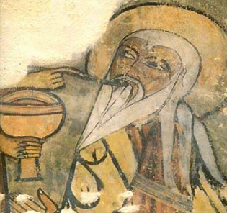 Melchizedek and the Grail
Melchizedek and the Grail
Let's do a bit of research and see where symbolism gets us by exploring the next interesting subject. On the right you see Abraham. Melchizedek (although unseen because of damage, is holding the cup in which he holds bread and wine, which were used in a ritual to thank the Mother Goddess for giving her body and blood to her children. This reminds us of the well-known ritual of the Holy Communion during Roman Catholic services. It also reminds us of Jesus' Last Supper. This ritual is ancient; it obviously goes back to the time of Melchizedek, from whom the Zadok Priests have evolved. The Zadok Priests were called the Teachers of Righteousness, the Sons of Light and Sons of God. According to Josephus, there were 83 Zadok Priests from Aaron to the fall of the Temple in Jerusalem in the first century AD. It all seems as if Jesus was also a Zadok Priest, as he was called the Teacher of Righteousness, the Son of God and because he was leading the bread and wine ritual at least once. So, how did he become a Zadok Priest?
For this we have to study the ancestry of Jesus and make a huge leap to a seemingly incredible assumption. Was Jesus - as we already mentioned above - indeed the son of Zachariah, who was the Zadok Priest at the time of Jesus' birth and who - according to custom - had impregnated Mary because he feared that his own wife Elizabeth had become too old? Remember Abraham and Sarai. In that case, John the Baptist, who was Zachariah's son by Elizabeth, had to be Jesus' half-brother. Zachariah was a Zadok Priest as well as the main heir of the Royal House of Hasmon. He was an uncrowned king, who had been forced to give his crown to the Roman puppet king Herod. So, we know that John the Baptist was his heir. Between Zacharias' death and John's death, John the Baptist would have been not only the Zadok Priest, but also the uncrowned king of Israel. After John's death, it would immediately pass on to the closest relative: Jesus, who was the second son of Zachariah by Mary. This would make Jesus' heirs not only of royal blood, but also sacred blood due to the lineage of the Zadok Priesthood. He was therefore a Son of God, as all Zadok Priests were so called, as well as the Messiah, the anointed king of Israel. As we know, the anointing was done by Mary Magdalene. She could have only been able to anoint him, if she were in function as a Zadok priest and thus of very high rank. King David was anointed by a Zadok priest as well. If only we knew more of her ancestors.
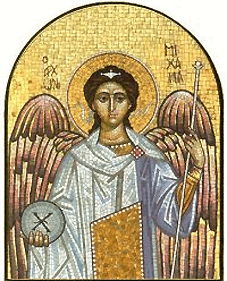 To find out more about the Zadok priests we must study Melchizedek. He was called the Grand Initiator, he seems to be more important than Abraham in Genesis 14:18 and was the eternal priest in Psalms 110:4. In Heb 7:3 he didn't even have parents and some seem to believe that he was perhaps a son of Sem, one of the sons of Noah. In the Dead Sea Scrolls he is connected to Archangel Michael (picture on the left). Is there a connection with Melchizedek and Archangel Michael?
To find out more about the Zadok priests we must study Melchizedek. He was called the Grand Initiator, he seems to be more important than Abraham in Genesis 14:18 and was the eternal priest in Psalms 110:4. In Heb 7:3 he didn't even have parents and some seem to believe that he was perhaps a son of Sem, one of the sons of Noah. In the Dead Sea Scrolls he is connected to Archangel Michael (picture on the left). Is there a connection with Melchizedek and Archangel Michael?
Archangel Michael symbolises our sub-consciousness which is sensitive to inspiration and our acting upon this. Archangel Michael also represents the impregnation of the Divine Feminine (Mother Earth, the - polarity, the cup), by the Divine Masculine (God, the + polarity, the blade or sword), through which life on earth - life in a material world - is possible. Mother Earth becomes Mother of God.
Mont St. Michel in France and St. Michael's Mount in Britain are both ancient Celtic sacred places which have been Christianised by having them dedicated to Archangel Michael. Does it refer to Hermetic knowledge, the science of nature, the Mother Goddess and the Grail? Is Melchizedek perhaps Michael Zadok, protector of knowledge? Knowledge as in the union of Science and Mysticism? Maybe you will be the one who finds out!!
Before I get off my soapbox and if you are fond of research, studying symbolism would be a wonderful start. Interesting books are the Kabala, the Kybalion and the Hermetic Teachings, 'The Hermetica' (The lost wisdom of the Pharaohs) by Timothy Freke and Peter Gandy (informative and easy reading) and 'Wisdom of the Mystic Masters' by Joseph J. Weed, which is a real eye opener and can change your life completely!
Also the works of Joseph Campbell are informative, 'The Grail Tradition' by John Matthews is very good, but also the secret sciences in Andrew Collin's book 'Gods of Eden: Egypt's lost legacy and the genesis of civilisation' is worth reading. 'On earth as it is in Heaven' by Greg Rigby explains revelations of French cathedral locations (as above, so below) and the books of Margaret Starbird on Mary Magdalene are also very informative. Marion Zimmer Bradley's Avalon books are very interesting, as they explain a lost culture that many people are trying to rediscover.
Obviously I would love you to read my own books about the above: WHITE LIE and THE EYE OF RA .
For those among you who have already 'been there done that bought the T-shirt', then the deeper Hermetica is the key to the old knowledge of the ancients. Perhaps you could read 'Subtle Body' by David V. Tansley or better still, try a one year membership with the Rosicrucian Order AMORC.
And for those who are going to embark on new research: The game is afoot, good hunting!
Also check out:History has been divided into two lines:
- The thick blue history line containing half-truths, which is visible for all.
- The thin red history line containing the truth, which is visible for only a few.
 We prepare ourselves by studying symbolism. Symbolism will give us a key towards the understanding of many secret signs and symbols used by initiates of several ancient orders and we find those symbols in many paintings, statues, carvings, cathedrals (especially the Gothic ones), coats of arms, etc. Let us look at the painting on the right. This is not Mother Mary. This is Mary Magdalene, Mariamne Migdal Eder, Watcher of the Tower (holistic astrologer) and the presumed companion and beloved disciple of Jesus in the 1st Century AD. She holds a closed book, which betrays that the history around her is not easy to discover. In her right hand she carries the mystical red rose, which refers to soul growth and the Great Work. Also, her index finger is pointing upwards. This is the so called 'John Gesture'. It refers to John the Baptist, Abba Yehohanan, who plays an important but forgotten role in history as Prince and King of Israel. Her hair is made up in the Egyptian style and the crescent moon she stands on is flanked by an Ankh and the seal of Amenhotep III, the founder of the Rosicrucians and father of Akhenaten. So, what does Mary Magdalene have in common with Egypt? Why is her skin colour dark and why is she standing on the crescent moon? Why does she have 12 stars around her head? Some of you will recognise symbols of the ancient Mother Goddess, who has had many names in the past. And here, with Mother Earth, everything begins.
We prepare ourselves by studying symbolism. Symbolism will give us a key towards the understanding of many secret signs and symbols used by initiates of several ancient orders and we find those symbols in many paintings, statues, carvings, cathedrals (especially the Gothic ones), coats of arms, etc. Let us look at the painting on the right. This is not Mother Mary. This is Mary Magdalene, Mariamne Migdal Eder, Watcher of the Tower (holistic astrologer) and the presumed companion and beloved disciple of Jesus in the 1st Century AD. She holds a closed book, which betrays that the history around her is not easy to discover. In her right hand she carries the mystical red rose, which refers to soul growth and the Great Work. Also, her index finger is pointing upwards. This is the so called 'John Gesture'. It refers to John the Baptist, Abba Yehohanan, who plays an important but forgotten role in history as Prince and King of Israel. Her hair is made up in the Egyptian style and the crescent moon she stands on is flanked by an Ankh and the seal of Amenhotep III, the founder of the Rosicrucians and father of Akhenaten. So, what does Mary Magdalene have in common with Egypt? Why is her skin colour dark and why is she standing on the crescent moon? Why does she have 12 stars around her head? Some of you will recognise symbols of the ancient Mother Goddess, who has had many names in the past. And here, with Mother Earth, everything begins. There are rumours that we haven't exactly found out everything about the history of our civilization. In fact, we know not even 1% of our history. Many traces of our past have been destroyed by disasters of nature and although orthodox historians and archaeologists refuse to believe that mankind is older than we may think, others are bringing in proof after proof that there was a civilization older than Jericho, older than Genesis. Maybe there was no Genesis. Maybe Genesis is just a symbolic story and we must look for the truth elsewhere. I'm sure that soon, books will be published with solid proof of the worlds of Atlantis and Lemuria. Traces of civilizations have been found which are many millennia older than our history books suggest and this shouldn't be a surprise. If the earth is billions of years old and the first upright humans walked on the earth at least 5 million years ago and were soon able to make a fire, then I am sure there have been at least several high civilizations that have been destroyed in some kind of natural catastrophe.
There are rumours that we haven't exactly found out everything about the history of our civilization. In fact, we know not even 1% of our history. Many traces of our past have been destroyed by disasters of nature and although orthodox historians and archaeologists refuse to believe that mankind is older than we may think, others are bringing in proof after proof that there was a civilization older than Jericho, older than Genesis. Maybe there was no Genesis. Maybe Genesis is just a symbolic story and we must look for the truth elsewhere. I'm sure that soon, books will be published with solid proof of the worlds of Atlantis and Lemuria. Traces of civilizations have been found which are many millennia older than our history books suggest and this shouldn't be a surprise. If the earth is billions of years old and the first upright humans walked on the earth at least 5 million years ago and were soon able to make a fire, then I am sure there have been at least several high civilizations that have been destroyed in some kind of natural catastrophe. The ancient people may have used a different science than we use today. Their science may be worth studying, so we can use it ourselves today. For example: The knowledge of medicine (herbs, flowers, plants, stones, energies, etc.), the power of the mind, the use of the earth's treasures e.g. crystals and stones, the science of vibration & sound, the knowledge of the soul, of nature, of the stars, of the future... That is why we need to get rid of our blinkers, think out of the box and learn from our ancestors, learn their science and see if it can aid ours. Why are there so many people against exploring the true origins of civilization? In the last 2000 years, powerful world ruling groups have carefully hidden many truths. To dominate the world, rulers need to keep the people stupid. Many people were forced to follow one specifically organized faith, so they could be controlled. All 'freethinkers' were killed, many times through the 'purge' of fire. The ancient knowledge - which was still present in the 1st century - would be carefully rooted out within the next 1500 years, but it didn't fall into oblivion. Ancient orders kept the knowledge safe and alive and passed it on orally, so not all was lost and sometimes we even discover hidden knowledge in symbolism, folktales, fairy tales, myths and legends, but also in cultures such as the Celts, who had taken over many things from e.g. the Egyptians. Think of the obelisks (Karnak Egypt, Carnac France), the enhancement of vibration (dolmens - temples/pyramids), their cult of the Mother Goddess and traces of Egyptian art in their artefacts (e.g. Gullgubbene, Scandinavia). So for those who seek the truth: The hidden history and hidden knowledge of the ancients is still among us, everywhere.
The ancient people may have used a different science than we use today. Their science may be worth studying, so we can use it ourselves today. For example: The knowledge of medicine (herbs, flowers, plants, stones, energies, etc.), the power of the mind, the use of the earth's treasures e.g. crystals and stones, the science of vibration & sound, the knowledge of the soul, of nature, of the stars, of the future... That is why we need to get rid of our blinkers, think out of the box and learn from our ancestors, learn their science and see if it can aid ours. Why are there so many people against exploring the true origins of civilization? In the last 2000 years, powerful world ruling groups have carefully hidden many truths. To dominate the world, rulers need to keep the people stupid. Many people were forced to follow one specifically organized faith, so they could be controlled. All 'freethinkers' were killed, many times through the 'purge' of fire. The ancient knowledge - which was still present in the 1st century - would be carefully rooted out within the next 1500 years, but it didn't fall into oblivion. Ancient orders kept the knowledge safe and alive and passed it on orally, so not all was lost and sometimes we even discover hidden knowledge in symbolism, folktales, fairy tales, myths and legends, but also in cultures such as the Celts, who had taken over many things from e.g. the Egyptians. Think of the obelisks (Karnak Egypt, Carnac France), the enhancement of vibration (dolmens - temples/pyramids), their cult of the Mother Goddess and traces of Egyptian art in their artefacts (e.g. Gullgubbene, Scandinavia). So for those who seek the truth: The hidden history and hidden knowledge of the ancients is still among us, everywhere. Egypt
EgyptEveryone knows that Egypt has a mystical culture dating back to pre-history. Their origin is still a mystery, their culture based on an older civilization and their great wisdom and power lives on in ancient orders such as the Rosicrucians. Powerful gods and goddesses ruled the world of the ancient Egyptians. In the west was the land of Sah and Ra; the underworld of Osiris and the tomb of the sun god Ra. The star systems in the heavens were copied onto the earth to make a symbolic gateway to their realms. Osiris and Isis, brother and sister as well as husband and wife, ruled the land and the afterlife, took care of the fertility of the earth so that the earth would produce food and drink, the body and blood of the mother goddess, for it is mother earth that we eat and drink. Isis gave birth to Horus and paved the road for future Christianity. Isis was the mother goddess, beloved by all. Around 1350 BC, around the time of Akhenaten in Egypt, there was a growing domination of the one and only god - who was both male and female - and it was in those days that Moses and Aaron took many things from the Egyptians, built the Ark of the Covenant and waited in the Sinai desert until the aftermath of the Santorini volcano eruption had died out and their goal, the 'promised land', would be habitable again. They had taken many things from the Egyptians. Perhaps also the god Thoth's laws and knowledge which was kept in a secret chamber to which a high priest only had access. Aaron was the High Priest of On (Heliopolis) before the Exodus. However, at a certain point in time, the mother goddess was no longer acknowledged as God's bride.
The children of Israel rebuilt the country and five centuries went by until the reign of David and Salomon. The Ark of the Covenant, which had been built just like all the other Egyptian mobile shrines that carried gods and goddesses, was about to be placed in a new temple in a new capital. Perhaps the knowledge of natural science; the wisdom of the ancients; the wisdom of Thoth, the Egyptian God of e.g. law and medicine, was kept inside the Ark. Since the days of Moses to the 1st century of our era (a period of 1350 years), the Jewish religion evolved and many separate cults, sects and orders were formed. The Mother Goddess became much less important, pushed aside by a lonely but dominant male deity and although Christianity tried to fill her empty throne by placing on it Jesus' Mother Mary, her origin practically disappeared.
 It is said that Mary Magdalene, a feminist, tried to give new life to the cult of the Mother Goddess or Black Madonna/Black Isis cult in France, where she may have spent the rest of her life. It is still not proven that she went there at all, but in folklore, in symbolism and in hidden books, many traces point very clearly in this direction. She most probably promoted the Black Madonna cult - the cult of Mother Earth - and at that time she was seen as the reincarnation of the goddess Isis or Artemis. Many churches dedicated to La Madeleine or Mary here in France are built on top of ancient Celtic sites with a sacred water source. The source is a very powerful symbol of the Mother Goddess.
It is said that Mary Magdalene, a feminist, tried to give new life to the cult of the Mother Goddess or Black Madonna/Black Isis cult in France, where she may have spent the rest of her life. It is still not proven that she went there at all, but in folklore, in symbolism and in hidden books, many traces point very clearly in this direction. She most probably promoted the Black Madonna cult - the cult of Mother Earth - and at that time she was seen as the reincarnation of the goddess Isis or Artemis. Many churches dedicated to La Madeleine or Mary here in France are built on top of ancient Celtic sites with a sacred water source. The source is a very powerful symbol of the Mother Goddess. It isn't surprising that Mother Mary, the 'Notre Dame' and 'La Madeleine' easily get mixed up. Both are often pictured with a blue robe, with stars around their heads, usually standing on a crescent moon or carrying a child. Although this refers to Mother Goddess symbolism, in history it is very likely that both women had children. According to Barbara Thiering, Maria Magdalene had 3 children with Jesus: Jesus Justus who followed Jesus' footsteps, Tamar who is said to have married Paul and a youngest son, thought to be John, who wrote the Book of Revelation in cryptic code containing many hidden messages. Especially the youngest child, who she had allegedly taken to France and with whom she may have been portrayed many times in history, could be confused with Jesus resting in Mother Mary's arms, but it doesn't matter who is who; it matters that they both represent God's lost bride; the Mother Goddess, the forgotten divine feminine that was once inseparable from Osiris, the divine masculine.
 This is interesting, because it is exactly this that we find in many a fairy tale. The prince in search of his princess, or the other way around. The princess fleeing for her life while chased by a wicked witch like in Snow White, or kept in a lonely tower away from men, like in Rapunzel. There may be a hidden symbolic connection between the name Septimania (an ancient Jewish Princedom in southern France) and the Seven Dwarfs from Snow White. Septimania was a place of refuge for Jewish refugees who had fled from Israel in the 1st century to escape the harsh Roman supression, so it may well have been a place of refuge for Mary Magdalene and many of her family and friends. Though the seven dwarfs protected Snow White, she was hunted down by the wicked queen. It's as if the fairy tale is a parable: the Magdalene's evolved cult was almost wiped out during the crusade against the Cathars in the 13th and 14th century and Snow White, well, she ate the poisoned apple, didn't she?
This is interesting, because it is exactly this that we find in many a fairy tale. The prince in search of his princess, or the other way around. The princess fleeing for her life while chased by a wicked witch like in Snow White, or kept in a lonely tower away from men, like in Rapunzel. There may be a hidden symbolic connection between the name Septimania (an ancient Jewish Princedom in southern France) and the Seven Dwarfs from Snow White. Septimania was a place of refuge for Jewish refugees who had fled from Israel in the 1st century to escape the harsh Roman supression, so it may well have been a place of refuge for Mary Magdalene and many of her family and friends. Though the seven dwarfs protected Snow White, she was hunted down by the wicked queen. It's as if the fairy tale is a parable: the Magdalene's evolved cult was almost wiped out during the crusade against the Cathars in the 13th and 14th century and Snow White, well, she ate the poisoned apple, didn't she?  Grail and The Female Principle
Grail and The Female PrincipleOccitania is an area where history has had full reign. The Celts and pre-celtic peoples worshipped the Mother Goddess. Their holy sites were holy water sources, caves, mountains and tellurian power lines on which they would place their dolmens and menhirs. The first connection we see is the cult of the bear, which is still celebrated in the mysterious Pyrenees. The bear was the incarnation of Odin in the northern Celtic world, while in the orient it was the companion of Artemis. We have the Great Bear (Ursus Major) and the Little Bear (Ursus Minor) in the stars and the bear was also a symbol of the moon and of resurrection. 'Arth Ur' means 'The Bear' and was the title of the leader of a tribe. Of course we think of another myth when we see the name Arthur. Also the name Arcas means 'bear' and there is a small village in the Corbières region of France called Arques (Arcas in Occitan).
 Around the 7th century BCE, the Mediterranean coast of Occitania was colonised by the Phoenicians and later by the Greeks and Romans. With them, they brought their cultures. There were also flourishing Jewish and Essene communities in this region and these people are considered to have been the ones who had brought viniculture to France, just a little while before the Romans arrived. The vine is a very powerful symbol in the Grail legends. Jesus was sometimes symbolised as a vine, as well as his 'forbidden' bloodline. Of course, Arthur and the Grail legends are connected and from the grail we once again arrive at Mary Magdalene and the alabaster jar. In it she kept the Nardus oil with which she anointed Jesus to become the Messiah, which means 'the anointed one'. However, we must consider that the presence of the jar could also simply refer to the Mother Goddess, since other Goddesses of Fertility in the Orient (for example Kuan Yin) are also depicted with a jar. The jar stands for the body, its contents for the soul.
Around the 7th century BCE, the Mediterranean coast of Occitania was colonised by the Phoenicians and later by the Greeks and Romans. With them, they brought their cultures. There were also flourishing Jewish and Essene communities in this region and these people are considered to have been the ones who had brought viniculture to France, just a little while before the Romans arrived. The vine is a very powerful symbol in the Grail legends. Jesus was sometimes symbolised as a vine, as well as his 'forbidden' bloodline. Of course, Arthur and the Grail legends are connected and from the grail we once again arrive at Mary Magdalene and the alabaster jar. In it she kept the Nardus oil with which she anointed Jesus to become the Messiah, which means 'the anointed one'. However, we must consider that the presence of the jar could also simply refer to the Mother Goddess, since other Goddesses of Fertility in the Orient (for example Kuan Yin) are also depicted with a jar. The jar stands for the body, its contents for the soul. Where there is smoke there is fire and we are beginning to understand that Mary Magdalene may have been Jesus' wife, especially because a Rabbi could only be called a Rabbi when he was married, preferably with children. On the right we see a relief from the church of Saint Volusien in Foix, depicting the Last Supper. It is clear that the person sitting at Jesus' left hand side is a woman, Mary Magdalene (with special thanks to author Bram Moerland for the photo). If there is any doubt whether the person next to Jesus on Da Vinci's Last Supper is a woman or not, this Last Supper reveals it clearly. Sitting next to the Master confirms her position. If they were indeed married, there may have been children and there is no reason why there would be no bloodline from them.
Where there is smoke there is fire and we are beginning to understand that Mary Magdalene may have been Jesus' wife, especially because a Rabbi could only be called a Rabbi when he was married, preferably with children. On the right we see a relief from the church of Saint Volusien in Foix, depicting the Last Supper. It is clear that the person sitting at Jesus' left hand side is a woman, Mary Magdalene (with special thanks to author Bram Moerland for the photo). If there is any doubt whether the person next to Jesus on Da Vinci's Last Supper is a woman or not, this Last Supper reveals it clearly. Sitting next to the Master confirms her position. If they were indeed married, there may have been children and there is no reason why there would be no bloodline from them.Jesus was a great Avatar; a Master and a healer; a holy man, who has said and done many good things. However, his ancestors are a mystery to us. In contrary to what people think, Jesus was no orthodox Jew but an Essene. Orthodox Jews called the Essenes 'Nazareni', which means 'heretics'. When we believe that Jesus had a physical body, nature demands him to have had a father as well as a mother. So, who was his earthly father? There are many theories about this. However, one possibility may have been overlooked. Perhaps High Priest/Zadok Priest Zachariah, the last male heir of the Hasmonean Royal House, is the real father of Jesus. Mary - daughter of Ann and Joachim who were from an important noble lineage - could have been chosen to give birth to Zachariah son, because his childless wife Elisabeth had become too old to get pregnant. The story could have been something like this: After impregnating Mary, it came out that Elisabeth was a few months pregnant after all and both women would give birth to sons. First, John (the Baptist), quickly followed by Jesus. This theory would explain much, as it would make John the king of Israel before Jesus. After John's death, Jesus would follow him up and become the anointed king of Israel and Judea, as well as Zadok priest, but the Romans refused to recognise him and seeing him as a threat to the Roman Empire, they had him crucified. They even mocked him by putting up a sign above his head, saying: 'Iesu Nazareni Rex Iudorum'. Jesus the heretic, king of the Jews.
 People have gone to great lengths to find out what his family tree really looks like and somehow they end up in the middle of several ruling classes in a turbulent medieval Europe. Think of Charlemagne, the house of Champagne and the first 9 (or 11?) knights of the Knights Templar, who just wanted to invade Jerusalem to retrieve a few what they considered family possessions and then leave. Many traces lead toward the Templar knights when we research the above. Noble families such as the Medici and many others in Europe intermarried because of this bloodline and thinking about this vine-bloodline, the term 'blue blood' may well have originated from this idea. When talking about important bloodlines for a personal research project, then it is interesting to dive into the origins of the Irish Tuatha de Danaan, the Celts, the 10 lost tribes of Israel, the Zadok Priesthood, the Tribe of Dan, the Royal Scyths (Isaac?), the origins of the Goths and Merovingians, the Saint Clair family, the Scottish Stewart family and the Habsburgs. One of the most probable heirs of the Grail bloodline could even be Karl von Habsburg. Whether this Grail bloodline has anything to do with Jesus or King David cannot be proven 100%, as historical records have been conveniently altered to fit the picture in many cases, but it is well possible that the Habsburg lineage is the oldest royal bloodline in the world. Now, their priorities are humanitarian and social work and of course, chivalry. Not for their glory, but for the glory of God.
People have gone to great lengths to find out what his family tree really looks like and somehow they end up in the middle of several ruling classes in a turbulent medieval Europe. Think of Charlemagne, the house of Champagne and the first 9 (or 11?) knights of the Knights Templar, who just wanted to invade Jerusalem to retrieve a few what they considered family possessions and then leave. Many traces lead toward the Templar knights when we research the above. Noble families such as the Medici and many others in Europe intermarried because of this bloodline and thinking about this vine-bloodline, the term 'blue blood' may well have originated from this idea. When talking about important bloodlines for a personal research project, then it is interesting to dive into the origins of the Irish Tuatha de Danaan, the Celts, the 10 lost tribes of Israel, the Zadok Priesthood, the Tribe of Dan, the Royal Scyths (Isaac?), the origins of the Goths and Merovingians, the Saint Clair family, the Scottish Stewart family and the Habsburgs. One of the most probable heirs of the Grail bloodline could even be Karl von Habsburg. Whether this Grail bloodline has anything to do with Jesus or King David cannot be proven 100%, as historical records have been conveniently altered to fit the picture in many cases, but it is well possible that the Habsburg lineage is the oldest royal bloodline in the world. Now, their priorities are humanitarian and social work and of course, chivalry. Not for their glory, but for the glory of God. The Grail legends
The Grail legendsAccording to Barbara Thiering, an authority on the Dead Sea Scrolls, Mary Magdalene was born in 3 AD, married Jesus and was banished by the Jews to an Essene colony in southern France around 44 CE. She wasn't alone; others also travelled to French shores. According to the legends, also Lazarus, Sidonius, Myriam Jacobe, Myriam Salome and Myriam Martha had come over. One story tells us how 2 of the Mary's (Mary Jacobe and Mary Salome) landed in the Provence just north of the Herault, near what is now called Stes Maries de la Mer in the Camarque. It was a local gypsy girl called Sarah, however, who became the patron saint of all the Gypsies. According to the gypsy legend of the Camarque, Sarah had rescued a ship in need who had come from Egypt by fetching help from a nearby fishing village. Still each year during the gypsy festival, this event is celebrated. The statue of sainte Sarah (and thus: not a black Madonna) is being carried through the streets of the village and taken into the sea to welcome the saints. There is no mention of Mary Magdalene in the gypsy legend. The Magdalen had probably come ashore somewhere else. Sarah's relics are still kept in the church. It is said that one of the Mary's had brought an object with which they could see the future. Sarah supposedly 'stole from the sun' by means of a stone. The gypsy with the crystal ball comes to mind, but also the Biblical Urim and Thummim divination stones, which once belonged to Zadok priest Aaron, brother of Moses. Perhaps these stones have been passed down in the Zadok priest's family bloodline?
 According to a legend, Mary Magdalene brought the Grail to France. We see here on the left how she arrived in France on a detail from a window in Chartres Cathedral. The Grail is, according to many, the cup Jesus drank from during his last meal. The cup that caught his blood after he had been pierced in his side by the Roman soldier Longinus during the crucifixion. This reminds me of an old ritual called the Hieros Gamos ritual. In the days of old, a small bowl was used to collect sacrificial blood. This blood would ensure the fertility of the earth for next year's crop (fertility cult). Of course Jesus' blood was also sacrificial and his sacrifice would ensure the fertility of the earth, or, in the case of the Christian dogma, the salvation of mankind. So, if Jesus' cup had indeed been brought to Europe - either by Joseph of Arimathea (Glastonbury) or Maria Magdalene (France) - then it may even exist as a material object and this reminds me of the famous cup of Melchizedek, who also did the bread and wine ritual thousands of years BCE. Since this ritual must have been done by many people throughout the centuries and if the cup should still exist, then it must have been made of unbreakable material.
According to a legend, Mary Magdalene brought the Grail to France. We see here on the left how she arrived in France on a detail from a window in Chartres Cathedral. The Grail is, according to many, the cup Jesus drank from during his last meal. The cup that caught his blood after he had been pierced in his side by the Roman soldier Longinus during the crucifixion. This reminds me of an old ritual called the Hieros Gamos ritual. In the days of old, a small bowl was used to collect sacrificial blood. This blood would ensure the fertility of the earth for next year's crop (fertility cult). Of course Jesus' blood was also sacrificial and his sacrifice would ensure the fertility of the earth, or, in the case of the Christian dogma, the salvation of mankind. So, if Jesus' cup had indeed been brought to Europe - either by Joseph of Arimathea (Glastonbury) or Maria Magdalene (France) - then it may even exist as a material object and this reminds me of the famous cup of Melchizedek, who also did the bread and wine ritual thousands of years BCE. Since this ritual must have been done by many people throughout the centuries and if the cup should still exist, then it must have been made of unbreakable material. So what about the Goral, a Hebrew word for 'Divination', referring to a (usually silver or golden) bowl - that often contained inscriptions and a magical square - and was used for divination. It was also used as a medicine cup, so the bearer could drink from it when ill. The drinker would then be healed from disease or poisoning, or simply remain healthy. Genesis 44 starts with Joseph who has his men hide his special cup in the luggage of one his brothers and it is referred to as the special cup that Joseph drank from and which he used for divination. This is of interest, because the word 'Goral' may have been the root of the word 'Grail'.
So what about the Goral, a Hebrew word for 'Divination', referring to a (usually silver or golden) bowl - that often contained inscriptions and a magical square - and was used for divination. It was also used as a medicine cup, so the bearer could drink from it when ill. The drinker would then be healed from disease or poisoning, or simply remain healthy. Genesis 44 starts with Joseph who has his men hide his special cup in the luggage of one his brothers and it is referred to as the special cup that Joseph drank from and which he used for divination. This is of interest, because the word 'Goral' may have been the root of the word 'Grail'.Of course there is a spiritual side to the material cup. Its spiritual symbolism. The search for a higher level of being; soul growth; the search for your inner wisdom and, of course, knowledge of the Hermetica to understand the big why and how and the concept of God and here we arrive exactly on the spot. It all seems to deal with the keeping and protecting of ancient, forbidden knowledge. Graham Hancock, together with Robert Bauval an authority on lost civilizations, has a strong feeling that the Grail and the Ark of the Covenant are - in a deeper symbolism - one and the same. In reality they may have existed as solid objects and are still very much sought after, but its symbolic value is far more important to us. What good is a beautiful book cover when you can't read the book? So in medieval times, when books as well as people were mercilessly burned when they did not follow the Roman Catholic power cult, it is no wonder that secret orders were working underground to protect all this knowledge, to keep it from oblivion.
 The great Brotherhoods
The great BrotherhoodsTrue initiates of the ancient orders were able to recognise the hidden messages in paintings and statues and other symbols. For outsiders, the question remains: what does it all mean? Here, Poussin - one of the initiates - has painted John the Baptist, the heir of Aaron, keeper of the Ark and immediately we spot the X in the trees. The X may refer to several things. St. Andrew is the patron saint of Scotland, so could it be referring to Scotland? Or does it refer to the Essene greeting, crossed arms with the right hand on the heart, a blink towards the knowledge of the Great White Brotherhood? Could it be the combination of the male symbol (^) and the female symbol (v)? Keep an eye out for the X in all paintings, images and statues as it may refer to a connection which is completely surprising. Or perhaps not...
However, there is one thing we may not overlook and that is the Female Principle, the Mother Goddess, Isis under her veil and the mysterious La Madeleine with her Mysticism. Mary Magdalene, as a feminist, was not very popular among the male disciples, for women in the orient - especially at that time - weren't considered equal. Jesus, however, was very fond of her and according to the Bible and other gnostic writings, he did consider her as equal. For a little while they were seen as if they were incarnates of Isis and Osiris, but when she was banished to France, she promoted the Mother Goddess, the Hermetic Teachings and holistic astrology and by doing so she may have paved the road for the Cathar movement, a gnostic Christian order that thrived in France more than 1000 years after the Magdalene's death. The Cathars were a Christian order that was not accepted by the Roman Catholic Church, as they did not obey the rules, doctrines and dogmas and so, the Cathar order was seen as a threat to the Church. During a ruthless crusade in the 13th century, most Cathars of southern France were killed.
Isn't it true that in countries where women are repressed, men are more violent and destructive, while as in western countries - where women are much more equal to men - men are more gentle and creative. Though these past 2000 years have been the age of Pisces, fish, the symbol of Jesus in Christianity, the following millennia will be the age of Aquarius, the water bearer, so let us hope that the female principle, symbolised in this new age, will be reinstated and world peace may indeed come closer.
 Melchizedek and the Grail
Melchizedek and the GrailLet's do a bit of research and see where symbolism gets us by exploring the next interesting subject. On the right you see Abraham. Melchizedek (although unseen because of damage, is holding the cup in which he holds bread and wine, which were used in a ritual to thank the Mother Goddess for giving her body and blood to her children. This reminds us of the well-known ritual of the Holy Communion during Roman Catholic services. It also reminds us of Jesus' Last Supper. This ritual is ancient; it obviously goes back to the time of Melchizedek, from whom the Zadok Priests have evolved. The Zadok Priests were called the Teachers of Righteousness, the Sons of Light and Sons of God. According to Josephus, there were 83 Zadok Priests from Aaron to the fall of the Temple in Jerusalem in the first century AD. It all seems as if Jesus was also a Zadok Priest, as he was called the Teacher of Righteousness, the Son of God and because he was leading the bread and wine ritual at least once. So, how did he become a Zadok Priest?
For this we have to study the ancestry of Jesus and make a huge leap to a seemingly incredible assumption. Was Jesus - as we already mentioned above - indeed the son of Zachariah, who was the Zadok Priest at the time of Jesus' birth and who - according to custom - had impregnated Mary because he feared that his own wife Elizabeth had become too old? Remember Abraham and Sarai. In that case, John the Baptist, who was Zachariah's son by Elizabeth, had to be Jesus' half-brother. Zachariah was a Zadok Priest as well as the main heir of the Royal House of Hasmon. He was an uncrowned king, who had been forced to give his crown to the Roman puppet king Herod. So, we know that John the Baptist was his heir. Between Zacharias' death and John's death, John the Baptist would have been not only the Zadok Priest, but also the uncrowned king of Israel. After John's death, it would immediately pass on to the closest relative: Jesus, who was the second son of Zachariah by Mary. This would make Jesus' heirs not only of royal blood, but also sacred blood due to the lineage of the Zadok Priesthood. He was therefore a Son of God, as all Zadok Priests were so called, as well as the Messiah, the anointed king of Israel. As we know, the anointing was done by Mary Magdalene. She could have only been able to anoint him, if she were in function as a Zadok priest and thus of very high rank. King David was anointed by a Zadok priest as well. If only we knew more of her ancestors.
 To find out more about the Zadok priests we must study Melchizedek. He was called the Grand Initiator, he seems to be more important than Abraham in Genesis 14:18 and was the eternal priest in Psalms 110:4. In Heb 7:3 he didn't even have parents and some seem to believe that he was perhaps a son of Sem, one of the sons of Noah. In the Dead Sea Scrolls he is connected to Archangel Michael (picture on the left). Is there a connection with Melchizedek and Archangel Michael?
To find out more about the Zadok priests we must study Melchizedek. He was called the Grand Initiator, he seems to be more important than Abraham in Genesis 14:18 and was the eternal priest in Psalms 110:4. In Heb 7:3 he didn't even have parents and some seem to believe that he was perhaps a son of Sem, one of the sons of Noah. In the Dead Sea Scrolls he is connected to Archangel Michael (picture on the left). Is there a connection with Melchizedek and Archangel Michael? Archangel Michael symbolises our sub-consciousness which is sensitive to inspiration and our acting upon this. Archangel Michael also represents the impregnation of the Divine Feminine (Mother Earth, the - polarity, the cup), by the Divine Masculine (God, the + polarity, the blade or sword), through which life on earth - life in a material world - is possible. Mother Earth becomes Mother of God.
Mont St. Michel in France and St. Michael's Mount in Britain are both ancient Celtic sacred places which have been Christianised by having them dedicated to Archangel Michael. Does it refer to Hermetic knowledge, the science of nature, the Mother Goddess and the Grail? Is Melchizedek perhaps Michael Zadok, protector of knowledge? Knowledge as in the union of Science and Mysticism? Maybe you will be the one who finds out!!
Before I get off my soapbox and if you are fond of research, studying symbolism would be a wonderful start. Interesting books are the Kabala, the Kybalion and the Hermetic Teachings, 'The Hermetica' (The lost wisdom of the Pharaohs) by Timothy Freke and Peter Gandy (informative and easy reading) and 'Wisdom of the Mystic Masters' by Joseph J. Weed, which is a real eye opener and can change your life completely!
Also the works of Joseph Campbell are informative, 'The Grail Tradition' by John Matthews is very good, but also the secret sciences in Andrew Collin's book 'Gods of Eden: Egypt's lost legacy and the genesis of civilisation' is worth reading. 'On earth as it is in Heaven' by Greg Rigby explains revelations of French cathedral locations (as above, so below) and the books of Margaret Starbird on Mary Magdalene are also very informative. Marion Zimmer Bradley's Avalon books are very interesting, as they explain a lost culture that many people are trying to rediscover.
Obviously I would love you to read my own books about the above: WHITE LIE and THE EYE OF RA .
For those among you who have already 'been there done that bought the T-shirt', then the deeper Hermetica is the key to the old knowledge of the ancients. Perhaps you could read 'Subtle Body' by David V. Tansley or better still, try a one year membership with the Rosicrucian Order AMORC.
And for those who are going to embark on new research: The game is afoot, good hunting!
Anneke Koremans